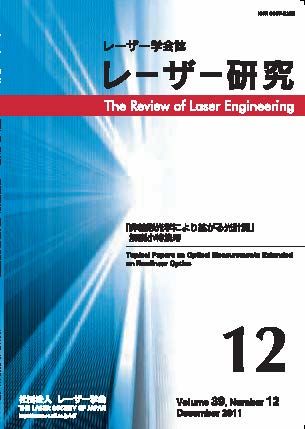All issues

Volume 44, Issue 9
Special Issue on Astrophysics Using Power Lasers
Displaying 1-9 of 9 articles from this issue
- |<
- <
- 1
- >
- >|
Special Issue on Astrophysics Using Power Lasers
Special Issue
Laser Review
-
Eisuke MIURA2016Volume 44Issue 9 Pages 576-
Published: 2016
Released on J-STAGE: December 17, 2020
JOURNAL FREE ACCESSDownload PDF (186K) -
Youichi SAKAWA2016Volume 44Issue 9 Pages 577-
Published: 2016
Released on J-STAGE: December 17, 2020
JOURNAL FREE ACCESSUtilizing high-temperature, high-density, high-flow-velocity, and high-pressure states observed in the Universe, by large-scale lasers in the laboratories, we aim at understanding plasma physics, astrophysics, and high-density/high-pressure physics. In this article, recent progress on laser plasma astrophysics and laser earth/planetary physics, and future perspective are presented.View full abstractDownload PDF (847K) -
Youichi SAKAWA2016Volume 44Issue 9 Pages 583-
Published: 2016
Released on J-STAGE: December 17, 2020
JOURNAL FREE ACCESSCollisionless shock is ubiquitous in space and astrophysical plasmas, and is believed to be a source of cosmic rays. In this article, three different types of collisionless shocks, i.e., magnetohydrodynamic, electromagnetic, and electrostatic shocks, in laboratory experiments are shown.View full abstractDownload PDF (1500K) -
Shinsuke FUJIOKA2016Volume 44Issue 9 Pages 589-
Published: 2016
Released on J-STAGE: December 17, 2020
JOURNAL FREE ACCESSLaser produced plasma is one of the brilliant x-ray source that has unique capabilities for use in a wide range of science. Here, we introduce that laser-produced x-ray source is very useful to simulate x-ray astronomical phenomena in the laboratory. A 0.5-keV Planckian x-ray source was created with laser driven implosion for producing non-local-thermodynamical-equilibrium (non-LTE) photoionized plasmas, which is a key to understand astronomical compact objects. Laboratory experiment of non- LTE photoionized plasma offers novel test bed for validation and verification of computational codes used in x-ray astronomy. Recently, it is demonstrated that kilo-tesla magnetic field can be generated by using capacitor-coil targets driven by high power laser beam. This strong magnetic field will offer new controll parameter to the laboratory x-ray astrophysics.View full abstractDownload PDF (1287K) -
Mitsuo NAKAI, Yasunobu ARIKAWA, Hiroaki NISHIMURA, Hui Chen2016Volume 44Issue 9 Pages 595-
Published: 2016
Released on J-STAGE: December 17, 2020
JOURNAL FREE ACCESSRelativistic electron-positron plasmas are believed to have an important role in the energetic phenomena in the universe, in the form of collimated jets or relativistic flow from pulsars and black-holes. Development of ultra-intense lasers are making possible to create this unique entity on the earth and open up an experimental frontier of astrophysics. Here presented are the review on the relativistic electron-positron plasma generation via Bethe-Heitler process by using high power lasers. It was demonstrated that more than 1012/kJ of pair creation per laser energy was possible and formation of the relativistic pair plasmas, which make it possible to investigate the collisionless shock in the laboratory, is expected by up-coming large laser facility with 10-kJ output energy. Relevant experiment at Osaka University is also reported.View full abstractDownload PDF (1640K) -
Toseo MORITAKA2016Volume 44Issue 9 Pages 602-
Published: 2016
Released on J-STAGE: December 17, 2020
JOURNAL FREE ACCESSMagnetic reconnection plays a key role in the rapid release of magnetic energy and the transition of magnetic field topology in space and astrophysical plasmas. Various experimental studies have been proposed and demonstrated magnetic reconnection with intense lasers. The configurations of a strong magnetic field, as well as laser-produced plasma, are essential in experimental designs. This paper introduces recent experimental studies by classifying the sources of strong magnetic fields.View full abstractDownload PDF (1645K) -
Sohsuke OHNO2016Volume 44Issue 9 Pages 608-
Published: 2016
Released on J-STAGE: December 17, 2020
JOURNAL FREE ACCESSIn this paper, we review the experimental studies of flyer acceleration using large-energy pulse lasers for hypervelocity impact experiments. We also show an application of laser-induced flyer acceleration to a mechanism of dinosaur-killing mass extinction at the end of the cretaceous period.View full abstractDownload PDF (445K) -
Tatsuhiro SAKAIYA, Toshihiko KADONO, Tadashi KONDO2016Volume 44Issue 9 Pages 613-
Published: 2016
Released on J-STAGE: December 17, 2020
JOURNAL FREE ACCESSIt is important to recover shock-compressed samples for understanding synthetic mechanism of highpressure phase, shock metamorphism, and shock-melt vein in meteorites. We developed recovery technique of the laser-shocked minerals at higher pressures (130-460 GPa) in high-power laser system. We used the single crystal olivine which is a major mineral of meteorites and Earth. The deformation, fracture, and phase identification of the recovered olivine were observed comprehensively by optical microscopy, field emission-scanning electron microscopy, electron backscatter diffraction, X-ray diffraction, and micro-Raman spectroscopy. There were three distinctive structures in the recovered sample. We estimated pressure attenuation rate of shock wave in the sample from the distribution of these structures. The attenuation rates of 2-3 in our experiments were larger than that in previous experiments and simulations.View full abstractDownload PDF (884K) -
Toshimori SEKINE2016Volume 44Issue 9 Pages 617-
Published: 2016
Released on J-STAGE: December 17, 2020
JOURNAL FREE ACCESSThe interiors of giant planets are at extreme conditions of temperature and pressure. Recent progressive results of equation of state of the Earth-type planets using laser-shock techniques are reviewed in the system SiO2-MgO above~200 GPa. The results play an important role to understand and model the properties and evolution of the planetary interiors consisting of silicate because they enable us to probe their detailed structures by a comparison with the observational results.View full abstractDownload PDF (638K)
- |<
- <
- 1
- >
- >|